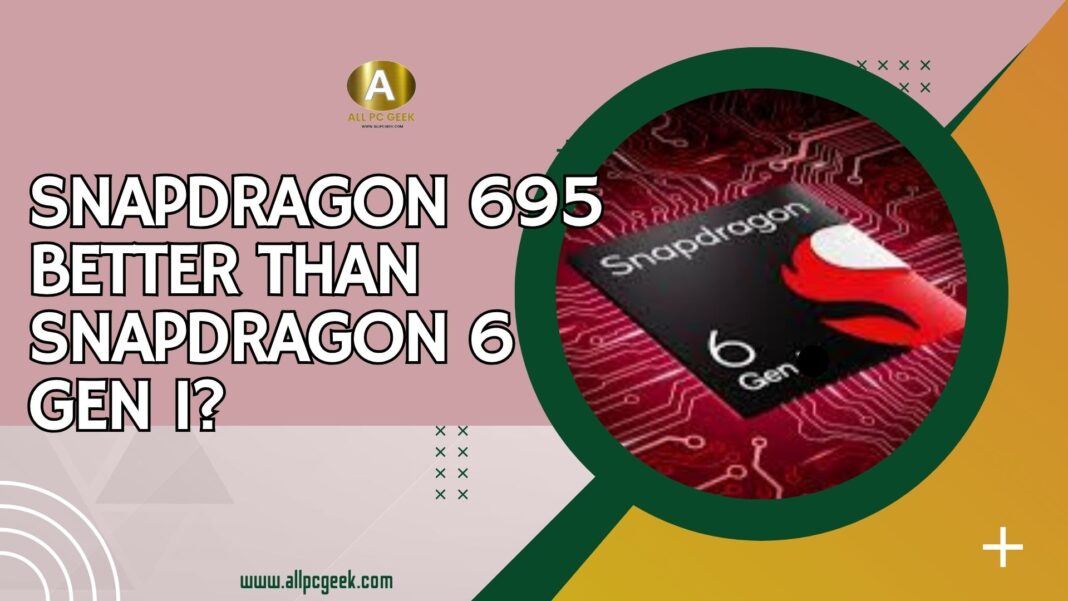When choosing a mid-range smartphone, the processor is a critical factor that impacts performance, battery life, and overall user experience. Qualcomm’s Snapdragon 695 and Snapdragon 6 Gen 1 are two popular chipsets powering many budget-friendly and mid-tier devices in 2025. But which one is better? In this comprehensive comparison, we dive into the Snapdragon 695 vs Snapdragon 6 Gen 1 debate, exploring their specs, performance, and real-world capabilities to help tech enthusiasts make an informed decision.
Understanding Qualcomm’s Mid-Range Processors
Qualcomm’s Snapdragon processors dominate the smartphone market, especially in the mid-range segment. The Snapdragon 695, launched in October 2022, has been a staple in devices like the Sony Xperia 10 IV and OnePlus Nord CE 3 Lite, offering reliable performance and 5G connectivity. The Snapdragon 6 Gen 1, introduced in September 2022, is a newer chipset designed to elevate mid-range devices with enhanced efficiency and power, seen in phones like the Sony Xperia 10 VI. This comparison will break down their differences to determine which chip suits your needs.
Keywords: Qualcomm Snapdragon, mid-range processors, Snapdragon 695, Snapdragon 6 Gen 1
Manufacturing Process: Efficiency Matters
One of the biggest differences between these chipsets is their manufacturing process. The Snapdragon 6 Gen 1 is built on a 4nm process, making it more power-efficient than the Snapdragon 695’s 6nm process. A smaller nanometer size typically means better energy efficiency, which translates to longer battery life and less heat generation during intensive tasks like gaming or multitasking. For users prioritizing efficiency, the 6 Gen 1 has a clear edge.
However, the Snapdragon 695’s 6nm process is still respectable, offering solid efficiency for everyday use. While it may consume slightly more power, real-world differences might be minimal for casual users. If you’re a power user, though, the 6 Gen 1’s modern architecture could make a noticeable difference.
Snapdragon 6 Gen 1 efficiency, Snapdragon 695 power consumption, 4nm vs 6nm process
CPU Performance: Powering Your Apps
Both processors feature eight-core CPUs, but their architectures differ slightly. The Snapdragon 695 uses a Kryo 660 CPU with two Cortex-A78 cores at 2.2 GHz for performance and six Cortex-A55 cores at 1.7 GHz for efficiency. The Snapdragon 6 Gen 1, on the other hand, has four Cortex-A78 cores at 2.2 GHz and four Cortex-A55 cores at 1.8 GHz, giving it a slight advantage in performance core count.
In practical terms, the 6 Gen 1 handles multitasking and demanding apps like video editors or social media platforms more smoothly. For example, switching between apps or running multiple browser tabs feels snappier on devices with the 6 Gen 1. The 695 is no slouch, but it may show slight lag in heavier workloads, making the 6 Gen 1 a better pick for tech enthusiasts who push their devices to the limit.
Snapdragon 695 CPU, Snapdragon 6 Gen 1 performance, mid-range smartphone multitasking
GPU Capabilities: Gaming and Graphics
Graphics performance is crucial for gaming and media consumption. The Snapdragon 695 is equipped with the Adreno 619 GPU, while the 6 Gen 1 boasts the more advanced Adreno 710. Benchmark tests, such as 3DMark, show the 6 Gen 1 scoring significantly higher (around 82% better) than the 695, indicating superior graphics rendering.
For casual gamers playing titles like PUBG Mobile or Call of Duty Mobile, both chips deliver decent performance at medium settings. However, the 6 Gen 1 supports higher frame rates and better visual quality, making it ideal for those who enjoy immersive gaming. If gaming isn’t your priority, the 695’s GPU is still sufficient for streaming HD content and light games.
Snapdragon 6 Gen 1 gaming, Snapdragon 695 GPU, Adreno 619 vs Adreno 710
Benchmark Scores: Measuring Raw Power
Benchmarks provide a clear picture of a processor’s capabilities. In AnTuTu 10, the Snapdragon 6 Gen 1 scores approximately 500,847, compared to the 695’s 411,374—a 21.75% improvement. Geekbench 6 also shows the 6 Gen 1 outperforming the 695 in both single-core and multi-core tests, reflecting better processing power for real-world applications.
While benchmarks aren’t everything, they indicate that the 6 Gen 1 handles intensive tasks like photo editing or 4K video playback more efficiently. The 695 remains competent for everyday tasks like browsing, texting, and streaming, but it lags behind in raw power.
Snapdragon 695 benchmarks, Snapdragon 6 Gen 1 AnTuTu, processor performance comparison
Connectivity: 5G and Beyond
Connectivity is a key consideration in 2025, with 5G becoming standard in mid-range devices. The Snapdragon 695 uses the X51 5G modem, supporting up to 2.5 Gbps download speeds, while the 6 Gen 1’s X62 5G modem offers up to 2.9 Gbps. Both chips provide robust 5G performance, but the 6 Gen 1’s modem supports faster uploads (1.6 Gbps vs 0.8 Gbps), which benefits content creators uploading large files.
Additionally, the 6 Gen 1 supports Wi-Fi 6E and Bluetooth 5.2, compared to the 695’s Wi-Fi 5 and Bluetooth 5.2. For users in areas with advanced network infrastructure, the 6 Gen 1 offers a slight edge in connectivity speed and reliability.
Snapdragon 695 5G, Snapdragon 6 Gen 1 connectivity, 5G modem comparison
Camera and Multimedia: Capturing the Moment
Both chipsets support up to 108 MP cameras and 4K video recording at 30 fps, making them capable of handling modern smartphone photography needs. However, the 6 Gen 1’s Spectra ISP supports up to 200 MP photos, offering more flexibility for high-resolution shots. This makes it a better choice for photography enthusiasts who want to future-proof their devices.
For video playback and streaming, both processors handle 4K content smoothly, with support for H.265, H.264, VP8, and VP9 codecs. The 6 Gen 1’s newer architecture may provide slightly smoother performance when editing or rendering videos, but the difference is subtle for casual users.
Snapdragon 6 Gen 1 camera, Snapdragon 695 multimedia, smartphone photography
Battery Efficiency: Lasting All Day
Battery life is a top priority for smartphone users. The Snapdragon 6 Gen 1’s 4nm process gives it an edge in power efficiency, potentially extending battery life by 10-15% compared to the 695, depending on the device’s optimization. For example, a phone with a 4500mAh battery might last a few hours longer with the 6 Gen 1 under similar usage conditions.
The Snapdragon 695, while less efficient, still offers solid battery performance for daily tasks like browsing, texting, and light gaming. If you’re a heavy user who streams or games extensively, the 6 Gen 1 is likely the better option.
Snapdragon 695 battery life, Snapdragon 6 Gen 1 efficiency, smartphone battery performance
Heat Management: Staying Cool Under Pressure
Heat management is critical for sustained performance. The Snapdragon 6 Gen 1’s 4nm process generates less heat than the 695’s 6nm process, especially during prolonged gaming or multitasking. User reports suggest the 695 can warm up noticeably during intensive tasks, though it rarely throttles performance.
For casual users, both chips manage heat adequately, but the 6 Gen 1’s modern design makes it better suited for demanding workloads without overheating concerns.
Snapdragon 6 Gen 1 heat management, Snapdragon 695 overheating, processor thermal performance
Future-Proofing: Which Chip Lasts Longer?
With smartphones often used for 2-3 years, future-proofing matters. The Snapdragon 6 Gen 1, being newer and built on a 4nm process, supports faster memory (LPDDR5 vs LPDDR4X) and has better compatibility with newer Android versions. This makes it a more future-proof choice for users planning to keep their devices longer.
The Snapdragon 695, while reliable, is starting to show its age in 2025. It may struggle with newer apps or OS updates over time, making the 6 Gen 1 a safer bet for long-term use.
Snapdragon 6 Gen 1 future-proof, Snapdragon 695 longevity, mid-range processor durability
Price vs Performance: Value for Money
The Snapdragon 695 powers budget-friendly devices, often priced between $200-$350, offering excellent value for casual users. The 6 Gen 1, found in slightly higher-tier mid-range phones ($300-$450), justifies its cost with better performance and efficiency.
If budget is a concern, the 695 provides solid performance for the price. However, if you can stretch your budget, the 6 Gen 1 offers a more premium experience without breaking the bank.
Snapdragon 695 value, Snapdragon 6 Gen 1 price, mid-range smartphone cost
Which Processor Should You Choose?
Choosing between the Snapdragon 695 and 6 Gen 1 depends on your needs. If you’re a casual user who browses, texts, and streams, the 695 offers reliable performance at a lower cost. For tech enthusiasts, gamers, or those seeking a future-proof device, the 6 Gen 1’s superior CPU, GPU, and efficiency make it the clear winner.
Call to Action: Have you used a phone with the Snapdragon 695 or 6 Gen 1? Share your experience in the comments below and let us know which processor you prefer! For more tech comparisons, subscribe to our blog or check out our other processor guides.
Need a laptop repair? Visit our Laptop Repair Services page for expert help.
Read more about our other innovative tech solutions.


